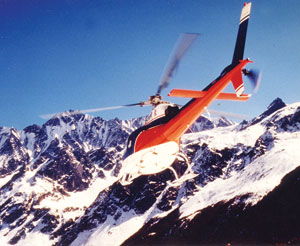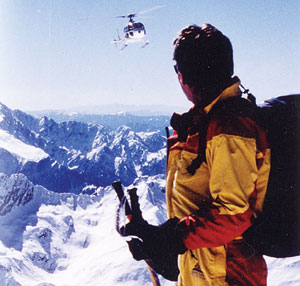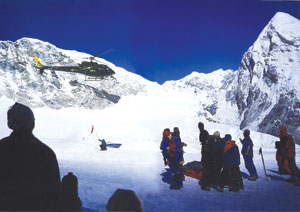 When the Mi-17 helicopter on a ferry flight from Makalu Base Camp failed to arrive in Lukla on Friday morning last week, Asian Airlines staff felt the first twinges of concern.
When the Mi-17 helicopter on a ferry flight from Makalu Base Camp failed to arrive in Lukla on Friday morning last week, Asian Airlines staff felt the first twinges of concern. A group of Spanish climbers had just come in, and the chopper had gone back to bring the rest of the expedition. But pre-monsoon clouds were closing in over the high passes guarding the remote Barun Valley in eastern Nepal. The Russian pilot, A Grevenikov, was a veteran of flying in the Caucases and the Himalaya and familiar with the terrain.
Search and rescue flights have been hampered by cloud cover, and only able to fly from dawn until 9AM, around when the clouds move in. By now it is certain that the helicopter crashed into one of the mountains, and that even if some of the six passengers and four crew survived the initial impact, they are unlikely to still be alive.
The accident came as we were preparing this survey of helicopter transport in Nepal, and once more underlined the dangers of flying in Himalayan terrain in bad weather. Aside from Maoist sabotage and mechanical problems, helicopter aviation in Nepal faces the chronic hazards of what aviation experts call controlled flight into terrain (CFIT)-the possibility of pilots misjudging altitude or position and flying into a mountain in poor visibility. But the same dangerous vertical terrain is also what makes helicopters are so indispensable in the Himalaya.
 The Russian-built Mi-17 has in the past ten years become the Tata truck of the airways in Nepal. Asian Airlines was a pioneer in introducing these versatile heavy-lift helicopters, but has now lost both its craft, one last week, and the other destroyed by Maoists in Surkhet last year. "There's nothing to match the lifting capacity and cost-effectiveness of the Mi-17," says Ang Tshering Sherpa, chairman of Asian Airlines. Sherpa is planning to add three more helicopters, one Mi- 17, and two versions of the same certified to carry passengers. With its capacity to carry four tons of cargo or 24 passengers, the Mi-17 ferries everything from hydro-power turbines and construction material to remote parts of the country. The Mi-17 has also become the mainstay of many mountaineering expeditions and the ferrying of grain to food deficit districts.
The Russian-built Mi-17 has in the past ten years become the Tata truck of the airways in Nepal. Asian Airlines was a pioneer in introducing these versatile heavy-lift helicopters, but has now lost both its craft, one last week, and the other destroyed by Maoists in Surkhet last year. "There's nothing to match the lifting capacity and cost-effectiveness of the Mi-17," says Ang Tshering Sherpa, chairman of Asian Airlines. Sherpa is planning to add three more helicopters, one Mi- 17, and two versions of the same certified to carry passengers. With its capacity to carry four tons of cargo or 24 passengers, the Mi-17 ferries everything from hydro-power turbines and construction material to remote parts of the country. The Mi-17 has also become the mainstay of many mountaineering expeditions and the ferrying of grain to food deficit districts. Although the Russian machines are rugged and cheap, they are no match for the altitude performance of another popular model in Nepal: the French-built Ecureil AS 350, which is operated by the army, Karnali Air and others. Although much smaller than the Mi-17 or even the Kawasaki BK-117, the Ecureil has carried out helicopter rescues of mountaineers at record altitudes, such as Madan KC's dramatic flight pick up of a climber from 20,000 ft on Mt Everest in 1996. That record was broken by Captain BN Sharma who in October 2000 landed on Island Peak at 22,000 ft in a daring rescue of a Greek trekker.
 These rescues are hazardous. The treacherous winds in thin air means that helicopters are easily buffeted and toppled over. A Karnali Air Ecureil came to grief at Makalu Base camp last month and Madan KC himself hit the Khumbu Glacier on an earlier rescue in the spring of 2000.
These rescues are hazardous. The treacherous winds in thin air means that helicopters are easily buffeted and toppled over. A Karnali Air Ecureil came to grief at Makalu Base camp last month and Madan KC himself hit the Khumbu Glacier on an earlier rescue in the spring of 2000. The inaccessibility of Nepal's rugged mountainous terrain makes helicopters the ideal mode of transport, but for decades they were out of bounds to everyone but the army and the Royal Flight. Today, thanks to the 1990 deregulation of the domestic airline industry, private helicopter operators are issued licenses and it has never been easier to hire a helicopter in Nepal.
The Royal Nepal Army itself has opted for Mi-17s and operates three of these to transport troops in its counter-insurgency operations. It is now seeking to add more helicopters to its fleet, and may even need to hire commercial pilots to fly the additional helicopters it wants to order.
For Captain Sabin Basnyat, 25, flying choppers is a passion. "Flying in Nepal is addictive. The adventure, the mountains, the diverse terrain, it is a thrill you get hooked on to." In March this year, Basnyat, a pilot with Karnali Air, flew a French group to Manang to reconnoitre possibilities of heli-skiing on the slopes south of Hunde airport. "Basically you fly skiers up to the slope and once they descend you pick them up and fly them up again. It's pretty taxing and one requires high altitude experience," says Basnyat.
 Basnyat is among many commercial pilots who are already flying charter flights for emergency rescue after Maoist raids. Pemba Sherpa of Dynasty Air is another. He says: "When I decided to train as a helicopter pilot, I never thought I'd be flying in combat zones, transporting dead bodies."
Basnyat is among many commercial pilots who are already flying charter flights for emergency rescue after Maoist raids. Pemba Sherpa of Dynasty Air is another. He says: "When I decided to train as a helicopter pilot, I never thought I'd be flying in combat zones, transporting dead bodies." "The army would probably require more manpower," says Captain BN Sharma, General Manager of Karnali Air. "If there was no emergency, business would definitely have been better for us. But so far, we haven't been hit hard like many of the fixed wing airlines,"
Karnali Air was the first private helicopter company to be set up by a former army pilot, Lieutenant Colonel Pun who is now looking at India and Bhutan to spread his wings.


